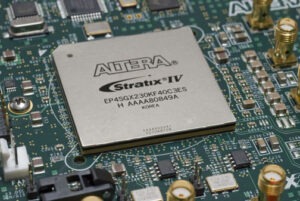Could Washington’s ban on US tech exports to China spark greater technological independence in Europe — and beyond?

As you may or may not already know, digital integrated circuits consist of millions of microscopic switches (“transistors”) orderly arranged in huge arrays of “logic gates,” which are connected by really thin wires that carry electric signals. Simplifying a lot, transistors and gates are always the same, and what a certain gate array does is determined by which wires are actually permanently connected to which gates at manufacturing time.
“Permanently” is the key here. A gate array wired to be a modem will always and only be a modem, and one wired to be a memory bank will always be a memory bank and nothing else. That’s why we call those devices ASICs, that is “application-specific integrated circuits.”
Field-programmable gate arrays, instead, are ICs whose connections between gates can be enabled in different ways at power-up, based on instructions from a configuration file.
Said this way, it seems like something that may only interest hardware fanatics, but it’s a really big deal, which came back to my mind a few days ago.
Everybody Should Love FPGAs
Why? First of all, because even though designing them with electronic design automation software may look like writing code, FPGAs are still hardware. There are plenty of parallel processing tasks that FPGAs, even when designed by novices, can do much faster than any assembly code written by any “10x programmer” for a generic CPU.
Second, while being slower, bigger, and more power-hungry than ASICs, FPGAs are really flexible and, above all, many orders of magnitude cheaper.
Designing and prototyping one ASIC that does one thing can cost millions of dollars, and all it takes to waste them is getting one wire wrong. One FPGA chip powerful enough to run Linux, instead, can cost as little as $100, can become (within reasonable limits!) every digital circuit you may need, and all it takes to change its functions or fix bugs is a power cycle with a different configuration file.
Summing up, FPGAs are perfect solutions for learning digital IC design, prototyping new devices, and generally creating any digital hardware you may think of, from home projects to real-world products, whose volumes would never repay the cost of doing them as ASICs. Linus Torvalds himself said in 2018 that if he were starting over, he might just program FPGAs instead of a new OS kernel.
The power of FPGAs is why I have said for many years now that it’s high time to make European FPGAs and bring FPGA design to the masses, and have consequently written FPGA tutorials for Linux, in 2009 and 2023 (here and here).
Why I Am Telling You This Now
The importance of FPGAs suddenly came back to my mind last week, when two seemingly unrelated news items appeared back to back on my screen. If you still need proof of how cool and useful FPGAs can be, check out the announcement of Klinge, a €99.95 (about $113.60 US) FPGA-based headless computer designed for secure networking and long-term Linux applications, usable standalone or as a blade server (if the Klinge isn’t enough, just search for Linux-compatible FPGA development boards!).
The other news was that VSWH (Very Stable White House) ordered Cadence, Synopsys, and other American EDA companies to halt sales to China. In the long term, this matters for everybody interested in FPGAs, not just Chinese corporations with huge state-backed pockets.
The reason is that, while it’s possible to design FPGA-based chips with open source or freeware tools, the proprietary software that those American companies sell is currently the only way there is to do it with the most powerful FPGAs with the highest possible performances. In other words, the biggest barrier to repeat with FPGAs what Linus Torvalds did with Linux may be the cost of the software, not the hardware.
Since the order originated from VSWH, I can’t rule out the possibility that it may have been retracted by the time you read this. However, I wouldn’t mind if it were confirmed indefinitely.
For a Europe that wants electronic sovereignty, the White House’s order would be the best possible confirmation that it must quickly build a robust local EDA industry, not just silicon foundries.
For advocates of open technology worldwide, that order may be an even bigger stroke of luck. Eventually, at least. It’s ex-CIA analysts, not me, who argue that chokehold measures like that on an industry as strategic as microelectronics may endanger the whole tariff truce reached in Geneva.
But if China (and India! Never forget India) reacted by developing and sharing open source alternatives to American EDA software, which isn’t science-fiction but just what they are already doing with RISC-V processors, eventually almost everybody will benefit. Don’t you think?

Marco Fioretti is an aspiring polymath and idealist without illusions based in Rome, Italy. Marco met Linux, Free as in Freedom Software, and the Web pre-1.0 back in the ’90s while working as an ASIC/FPGA designer in Italy, Sweden, and Silicon Valley. This led to tech writing, including but not limited to hundreds of Free/Open Source tutorials. Over time, this odd combination of experiences has made Marco think way too much about the intersection of tech, ethics, and common sense, turning him into an independent scholar of “Human/digital studies” who yearns for a world with less, but much better, much more open and much more sensible tech than we have today.






